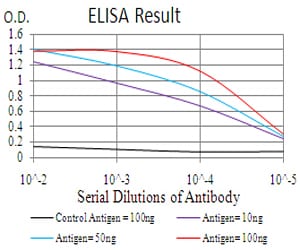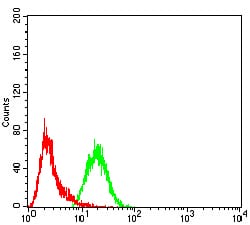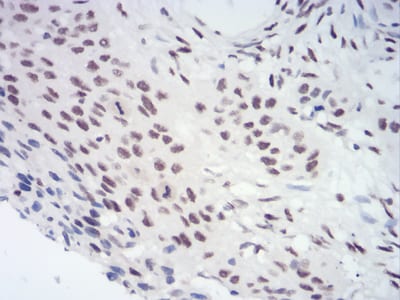



| WB | 咨询技术 | Human,Mouse,Rat |
| IF | 咨询技术 | Human,Mouse,Rat |
| IHC | 1/200 - 1/1000 | Human,Mouse,Rat |
| ICC | 技术咨询 | Human,Mouse,Rat |
| FCM | 1/200 - 1/400 | Human,Mouse,Rat |
| Elisa | 1/10000 | Human,Mouse,Rat |
| Aliases | HECH; HP1-GAMMA; HP1Hs-gamma |
| Entrez GeneID | 11335 |
| clone | 6D1C4 |
| WB Predicted band size | 20.8kDa |
| Host/Isotype | Mouse IgG1 |
| Antibody Type | Primary antibody |
| Storage | Store at 4°C short term. Aliquot and store at -20°C long term. Avoid freeze/thaw cycles. |
| Species Reactivity | Human |
| Immunogen | Purified recombinant fragment of human CBX3 (AA: 1-183) expressed in E. Coli. |
| Formulation | Purified antibody in PBS with 0.05% sodium azide |
+ +
以下是3篇关于CBX3抗体的参考文献概览(信息基于公开文献整理,部分内容为简化概括):
---
1. **文献名称**: *CBX3/HP1γ promotes tumor cell proliferation by activating ERK1/2 pathway in colorectal cancer*
**作者**: Li Y, et al.
**摘要**: 本研究使用CBX3抗体进行免疫组化(IHC)和Western blot分析,发现CBX3在结直肠癌组织中高表达,并通过调控ERK信号通路促进肿瘤增殖。抗体特异性通过siRNA敲低实验验证。
---
2. **文献名称**: *HP1γ regulates stem cell self-renewal in human embryonic stem cells through modulation of chromatin structure*
**作者**: Singh AM, et al.
**摘要**: 通过免疫荧光(IF)和ChIP-seq技术结合CBX3抗体,证明CBX3通过维持异染色质结构调控胚胎干细胞的自我更新能力。实验中使用的小鼠单克隆抗体在多种细胞模型中验证了特异性。
---
3. **文献名称**: *The role of CBX3 in DNA damage response and genomic stability*
**作者**: Zhang X, et al.
**摘要**: 利用CBX3抗体进行流式细胞术和共聚焦显微镜分析,发现CBX3通过招募DNA修复蛋白(如ATM)参与DNA损伤修复。研究强调抗体在识别磷酸化修饰后CBX3构象变化中的可靠性。
---
如需具体文献链接或更详细内容,可提供DOI或通过PubMed检索标题进一步获取原文。
The CBX3 antibody is a research tool used to detect Chromobox homolog 3 (CBX3), a member of the Chromobox protein family. CBX3. also known as HP1γ (Heterochromatin Protein 1 gamma), is a key component of epigenetic regulation. It plays a role in gene silencing, chromatin organization, and maintenance of heterochromatin by binding to trimethylated lysine 9 on histone H3 (H3K9me3), a hallmark of transcriptionally repressive chromatin. As part of the Polycomb repressive complex 1 (PRC1), CBX3 contributes to stable gene repression and cellular differentiation processes.
CBX3 antibodies are widely employed in studies exploring gene expression regulation, cellular senescence, and cancer biology. They enable techniques like Western blotting, immunofluorescence, and chromatin immunoprecipitation (ChIP) to investigate CBX3's localization, interactions, and functional roles. Dysregulation of CBX3 has been linked to tumor progression, with studies showing both oncogenic and tumor-suppressive roles depending on cellular context. For example, elevated CBX3 expression correlates with poor prognosis in certain cancers, while its loss may disrupt genome stability.
Researchers use CBX3 antibodies to dissect its involvement in stem cell pluripotency, DNA repair, and responses to environmental stress. These tools are critical for understanding how epigenetic dysregulation contributes to disease and for developing targeted therapies.
×